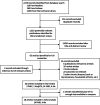Relationship of arterial tonometry and exercise in patients with chronic heart failure: a systematic review with meta-analysis and trial sequential analysis
- PMID: 35909113
- PMCID: PMC9341099
- DOI: 10.1186/s12872-022-02792-6
Relationship of arterial tonometry and exercise in patients with chronic heart failure: a systematic review with meta-analysis and trial sequential analysis
Abstract
Background: Arterial stiffness is a common characteristic in patients with chronic heart failure (CHF), and arterial tonometric technologies related to arterial stiffness are novel and effective methods and have an important value in the diagnosis and prognosis of CHF. In terms of ameliorating arterial stiffness in patients with CHF, exercise training is considered an adjuvant treatment and also an effective means in the diagnosis and judgment of prognosis. However, there are huge controversies and inconsistencies in these aspects. The objective of this meta-analysis was to systematically test the connection of arterial tonometry and exercise in patients with CHF.
Methods: Databases, including MEDLINE, EMBASE, and Cochrane Central Register of Controlled Trials (CENTRAL) in The Cochrane Library, were accessed from inception to 7 March 2022. The meta-analysis was then conducted, and trial sequential analysis (TSA) was performed jointly to further verify our tests and reach more convincing conclusions by using RevMan version 5.4 software, STATA version 16.0 software, and TSA version 0.9.5.10 Beta software.
Results: Eighteen articles were included, with a total of 876 participants satisfying the inclusion criteria. The pooling revealed that flow-mediated dilation (FMD) was lower in basal condition [standardized mean difference (SMD): - 2.28%, 95% confidence interval (CI) - 3.47 to - 1.08, P < 0.001] and improved significantly after exercise (SMD: 5.96%, 95% CI 2.81 to 9.05, P < 0.001) in patients with heart failure with reduced ejection fraction (HFrEF) compared with healthy participants. The high-intensity training exercise was more beneficial (SMD: 2.88%, 95% CI 1.78 to 3.97, P < 0.001) than the moderate-intensity training exercise to improve FMD in patients with CHF. For augmentation index (AIx), our study indicated no significant differences (SMD: 0.50%, 95% CI - 0.05 to 1.05, P = 0.074) in patients with heart failure with preserved ejection fraction (HFpEF) compared with healthy participants. However, other outcomes of our study were not identified after further verification using TSA, and more high-quality studies are needed to reach definitive conclusions in the future.
Conclusions: This review shows that FMD is lower in basal condition and improves significantly after exercise in patients with HFrEF compared with healthy population; high-intensity training exercise is more beneficial than moderate-intensity training exercise to improve FMD in patients with CHF; besides, there are no significant differences in AIx in patients with HFpEF compared with the healthy population. More high-quality studies on this topic are warranted.
Keywords: Arterial stiffness; Arterial tonometry; Chronic heart failure; Exercise; Meta-analysis.
© 2022. The Author(s).
Conflict of interest statement
The authors declares that they have no competing interests.
Figures








Similar articles
-
Effect of endurance exercise training on endothelial function and arterial stiffness in older patients with heart failure and preserved ejection fraction: a randomized, controlled, single-blind trial.J Am Coll Cardiol. 2013 Aug 13;62(7):584-92. doi: 10.1016/j.jacc.2013.04.033. Epub 2013 May 9. J Am Coll Cardiol. 2013. PMID: 23665370 Free PMC article. Clinical Trial.
-
Ivabradine Improves Cardiac Function and Increases Exercise Capacity in Patients with Chronic Heart Failure.Int Heart J. 2019 Jul 27;60(4):899-909. doi: 10.1536/ihj.18-559. Epub 2019 Jul 12. Int Heart J. 2019. PMID: 31308326
-
The impact of exercise training for chronic heart failure patients with cardiac resynchronization therapy: A systematic review and meta-analysis.Medicine (Baltimore). 2021 Apr 2;100(13):e25128. doi: 10.1097/MD.0000000000025128. Medicine (Baltimore). 2021. PMID: 33787595 Free PMC article.
-
The effect of exercise training and physiotherapy on diastolic function, exercise capacity and quality of life in patients with heart failure with preserved ejection fraction: a systematic review and meta-analysis.Kardiol Pol. 2021;79(10):1107-1115. doi: 10.33963/KP.a2021.0101. Epub 2021 Sep 2. Kardiol Pol. 2021. PMID: 34472077
-
Effectiveness of exercise training on arterial stiffness and blood pressure among postmenopausal women: a systematic review and meta-analysis.Syst Rev. 2024 Jul 2;13(1):169. doi: 10.1186/s13643-024-02589-y. Syst Rev. 2024. PMID: 38956626 Free PMC article.
Cited by
-
Endothelial, Vascular and Sympathetic Alterations as Therapeutic Targets in Chronic Heart Failure.Biomedicines. 2023 Mar 6;11(3):803. doi: 10.3390/biomedicines11030803. Biomedicines. 2023. PMID: 36979781 Free PMC article. Review.
References
-
- Herrington DM, Fan L, Drum M, Riley WA, Pusser BE, Crouse JR, Burke GL, McBurnie MA, Morgan TM, Espeland MA. Brachial flow-mediated vasodilator responses in population-based research: methods, reproducibility and effects of age, gender and baseline diameter. J Cardiovasc Risk. 2001;8(5):319–328. doi: 10.1097/00043798-200110000-00012. - DOI - PubMed
Publication types
MeSH terms
LinkOut - more resources
Full Text Sources
Medical
Research Materials

